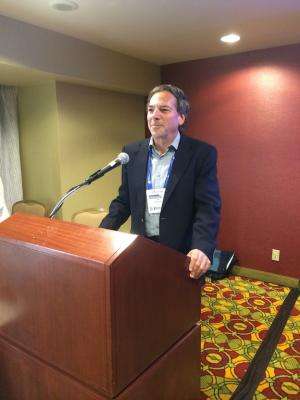No Fukushima radiation found in coastal areas

It was raining when Eric Norman, Berkeley Lab physicist and University of California (UC) Berkeley professor of Nuclear Engineering, heard about the nuclear-reactor meltdown in Fukushima, Japan. "I immediately thought of Chernobyl," he says, referring to the "nuclear rain" that fell in the days that followed the 1986 disaster in Ukraine. Norman wanted to know if, following the March 11, 2011 Fukushima breach, radioactivity could be found in Bay Area precipitation. He and his students collected weeks' worth of rainwater around Berkeley Campus to find out.
The results: low levels of a number of different radioactive nuclei produced by the fission of uranium-235 including, cesium-134, cesium-137, and iodine-131. (The number after the element represents the total number of protons and neutrons in the atom's nucleus.) "The levels we saw were detectable, but low and not a health hazard to anyone," Norman says. With findings in hand, he informed the local media that there was nothing to worry about, he says, and did his best to stress the lack of dangerous radioactivity in the rainwater.
Fast-forward a couple years. "I thought that was the end of it until I started seeing reports on the Internet and elsewhere," he explained at last month's 2014 meeting of the American Chemical Society in San Francisco, CA. People were again concerned about health hazards caused by the radiation.
"I think part of the reason for that was there were reports of continuing leaks and releases of radioactivity—it wasn't just a one-time thing—and people began to think of the idea of radiation being transported across the Pacific, which of course will happen," Norman says. "I don't know where they got the numbers, but they were claiming very high numbers that were causing health effects on people especially children."
Norman didn't immediately dismiss these new claims, but he couldn't find any up-to-date measurements of environmental radiation. So he decided to conduct his own study. In 2013, he and his students tested radiation levels in fish, plants, milk, seawater, and salt from a variety of locations throughout the Pacific Ocean and coastal regions.
They compared the ratio of radioactive isotopes in the new samples to a sample Norman had collected years before: about a month after the Fukushima disaster, he noticed his backyard weeds had grown high from all the rain. Upon testing these weeds he found extremely low but detectable levels of cesium-134 and cesium-137, still well below limits for safety and health concerns.
If any of the new samples contained these two isotopes in the same ratio as that of the weeds from 2011, it would indicate the presence of Fukushima radiation.
With the help of Al Smith, physicist at Berkeley Lab and one of the world's experts on background gamma ray counting, and Keenan Thomas from UC Berkeley, the team analyzed and interpreted the results. They especially expected to find at least some cesium isotopes in the seaweed since it concentrates potassium, an element that's in the same column of cesium on the periodic table. "We looked very hard," Norman says. The scientists sampled their fish, seaweed, and other Pacific products from Hawaii, the Philippines, the West Coast areas, and Japan. But none of these samples showed any indication of radiation from Fukushima, Norman says.
Why were radiation levels in these samples so low? "Many radioactive isotopes we saw in the rain water were very short lived," Norman explains. Iodine-131, for instance, has a half-life of just eight days. Additionally, dilution from ocean water plays a significant role. "We're a long way from Japan and there's a lot of water in the Pacific," he says. "Whatever gets dumped in the ocean will get diluted by enormous factors."
Even so, Norman and his team continue to test samples so that they'll have up-to-date data to counter any scare claims of Fukushima radiation. Recently he's grown grapes in his yard and analyzed leaf samples. The isotope levels from his backyard flora, so low to begin with in 2011, have now completely faded away.
More information: Norman EB, Angell CT, Chodash PA (2011) "Observations of Fallout from the Fukushima Reactor Accident in San Francisco Bay Area Rainwater." PLoS ONE 6(9): e24330. DOI: 10.1371/journal.pone.0024330
A. Smith, K. Thomas, E. Norman, D. Hurley, B. Lo, Y. Chan, P. Guillaumon and B. Harvey, "Measurements of Fission Products from the Fukushima Daiichi Incident in San Francisco Bay Area Air Filters, Automobile Filters, Rainwater, and Food," Journal of Environmental Protection, Vol. 5 No. 3, 2014, pp. 207-221. DOI: 10.4236/jep.2014.53025.
Journal information: PLoS ONE
Provided by Lawrence Berkeley National Laboratory



















